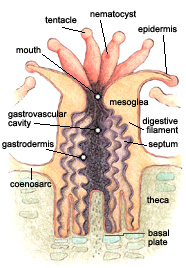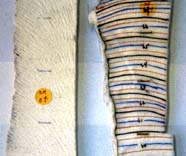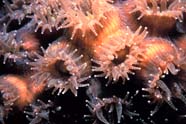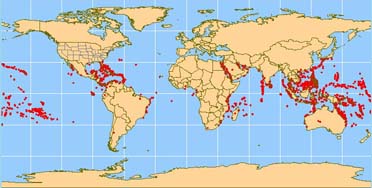- ABOUT US
- PROGRAM AREAS
- CONSERVATION APPROACH
- EDUCATION
- MULTIMEDIA
Coral Facts
What is a coral? (Coral: Plant, Animal, or Mineral?)

Corals are animals, even though they may exhibit some of the characteristics of plants and are often mistaken for rocks. In scientific classification, corals fall under the phylum Cnidaria and the class Anthozoa. They are relatives of jellyfish and anemones.
As with many other types of animals, different species of coral are found in different habitats and different locations around the world. For example, similar but distinct species of Acropora coral have evolved in the Pacific Ocean and the Caribbean.
What is the difference between hard and soft coral?
Hard corals, also known as scleractinian and stony coral, produce a rigid skeleton made of calcium carbonate (CaCO3) in crystal form called aragonite. Hard corals are the primary reef-building corals. Colonial hard corals, consisting of hundreds to hundreds of thousands of individual polyps, are cemented together by the calcium carbonate 'skeletons' they secrete. Hard corals that form reefs are called hermatypic corals.
Soft coral, also known as Alcyonacea and ahermatypic coral, do not produce a rigid calcium carbonate skeleton and do not form reefs, though they are present in a reef ecosystems. Soft corals are also mostly colonial; what appears to be a single large organism is actually a colony of individual polyps combined to form a larger structure. Visually, soft coral colonies tend to resemble trees, bushes, fans, whips, and grasses.
How fast do corals grow?

Hard Coral: The rate at which a stony coral colony lays down calcium carbonate depends on the species, but some of the branching species can increase in height or length by as much as 10 cm a year (about the same rate at which human hair grows). Other corals, like the dome and plate species, are more bulky and may only grow 0.3 to 2 cm per year.
Soft Coral: A soft coral colony has the growth potential of two to four centimeters per year.
What are zooxanthellae?
Most reef-building corals have a mutually beneficial relationship with a microscopic unicellular algae called zooxanthellae that lives within the cells of the coral's gastrodermis. As much as 90 percent of the organic material the algae manufacture photosynthetically is transferred to the host coral tissue. Due to the need for sunlight to conduct photosynthesis, this type of energy production happens during daylight hours.
What do corals eat?

During feeding, a coral polyp will extend its tentacles out from its body and wave them in the water current where they encounter zooplankton, bacterioplankton, or other food particles. A coral's prey is typically microscopic zooplankton.
How do corals reproduce?
Broadcast Spawning:
About three-quarters of all stony coral species are broadcast spawners.
Along many reefs, coral spawning occurs as a synchronized event, when many coral species in an area release their eggs and sperm at about the same time. The timing of a broadcast spawning event is very important because corals cannot move to make reproductive contact with each other. Because colonies may be separated by wide distances, the release of sperm and eggs must be precisely timed, and usually occurs in response to multiple environmental cues.
Brooding:The remaining quarter of coral species are brooders.
Brooding species generally disperse their larvae shorter distances from the mother colony than broadcasters. They generally have high success in recruiting new larvae into established colonies, but many of these species reach only small colony size and thus do not contribute much to the overall growth of a reef.
Budding: In this form of asexual reproduction, new polyps bud off from parent polyps to expand or begin new colonies. This occurs when the parent polyp reaches a certain size and divides. This process continues throughout the animal's life and produces polyps that are genetically identical to the parent polyp.
Fragmentation: This method also allows a portion of an entire colony to establish a new colony. If a portion of a larger colony is broken off from the main colony during a storm or boat grounding, the separated individuals can start new coral colonies that are genetically identical to the parent colony. However, the success of the fragments in establishing a new colony is dependent upon whether they are exposed to favorable growth conditions. For instance, fragments exposed to strong wave action will find it difficult to settle on a substrate for continued growth.
Where are corals found?

Coral communities can be found in shallow or deep waters.
Shallow water coral reefs occupy approximately 284,300 square kilometers of the sea floor (less than 1%). Reef-building corals prefer clear and shallow water, where lots of sunlight filters through to their symbiotic algae. It is possible to find coral reefs at depths exceeding 91 m, but reef-building corals generally grow best at depths shallower than 70 m. Other factors influencing coral distribution are availability of hard-bottom substrate, and the presence of species that help control macroalgae, like urchins and herbivorous fish.
Mesophotic coral ecosystems are typically found at depths ranging from 30-40 m and extending to over 150 m in tropical and subtropical regions. Mesophotic coral ecosystems may be regarded as extensions of shallow coral ecosystems and often share common species. These ecosystems are characterized by the presence of corals and associated communities found at water depths where light penetration is low. The term mesophotic literally translates to 'meso' for middle and 'photic' for light. The fact that they contain zooxanthellae and require light distinguishes these corals from true deep-sea corals. Often the corals will grow in forms that allow them to get as much light as possible
Deep-sea coral communities thrive on continental shelves and slopes around the world, sometimes thousands of meters below the ocean surface. Unlike the well-studied tropical coral reefs, these corals inhabit deeper waters on continental shelves, slopes, canyons, and seamounts in waters ranging from 50 m to over 3,000 m in depth. A few species also extend into shallower, cold waters in the northern latitudes. Deep-sea corals are found in all oceans, including the Subantarctic. Like their shallow-dwelling relatives, deep-sea corals exhibit high biodiversity.
Which ocean basin has the highest number of coral species?
Shallow tropical reefs in the Indian and Pacific Oceans boast the most coral species. To date, almost 800 species of reef-building corals have been identified, with new discoveries occurring each year. Of the known species, the majority are found in the Indian and Pacific oceans—an area known as the Indo-Pacific region. There are over 600 species of coral found in the Coral Triangle alone—a region encompassing the waters around the Philippines, Malaysia, Indonesia, Timor-Leste, Papua New Guinea, and the Solomon Islands—making this region the global hotspot of coral diversity.
About Us

The NOAA Coral Reef Conservation Program was established in 2000 by the Coral Reef Conservation Act. Headquartered in Silver Spring, Maryland, the program is part of NOAA's Office for Coastal Management.

The Coral Reef Information System (CoRIS) is the program's information portal that provides access to NOAA coral reef data and products.
Work With US
U.S. Coral Reef Task Force
Funding Opportunities
Employment
Fellowship Program
Contracting Assistance
Graphic Identifier
Featured Stories Archive

Access the archive of featured stories here...
Feedback
Thank you for visiting NOAA’s Coral Reef Conservation Program online. Please take our website satisfaction survey. We welcome your ideas, comments, and feedback. Questions? Email coralreef@noaa.gov.
Stay Connected
Contact Us
NOAA’s Coral Reef Conservation Program
SSMC4, 10th Floor
1305 East West Highway
Silver Spring, MD 20910
coralreef@noaa.gov
